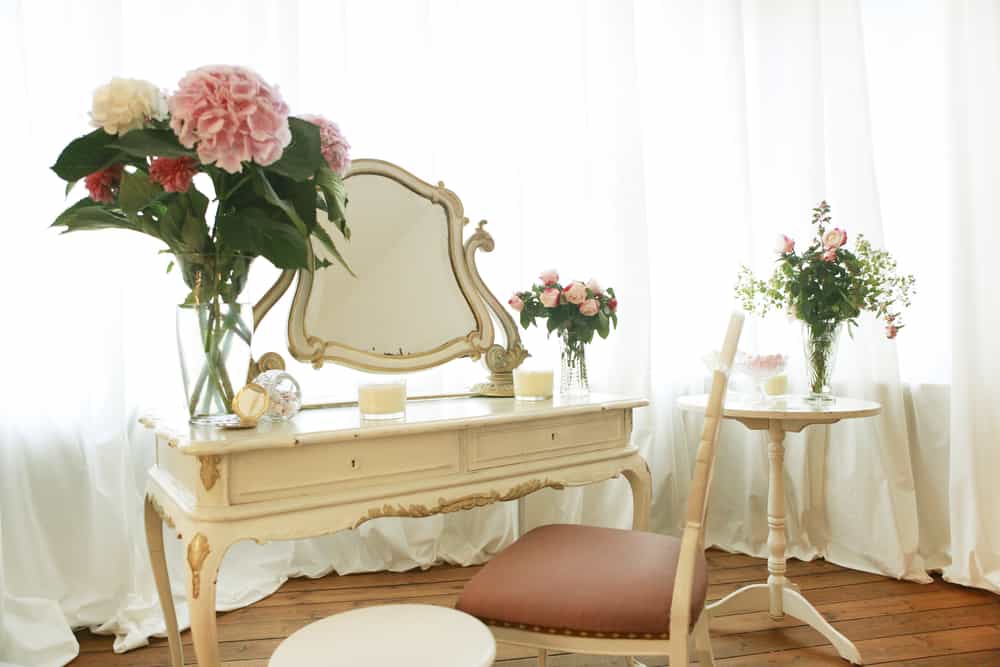Have you recently bought or been given a vintage dressing table and you want to know if it is an antique? Do you want to buy an antique dressing table but don’t know how to make sure it is genuine?
This article aims to provide the answers to the above questions, whilst also giving some valuable insight into the history and value of them. Read on to ensure you make the best decisions when purchasing or appraising your dressing table.
Table of Contents
History of Dressing Tables
Early History
According to Styylish, the history of the dressing or vanity table goes right back to the Egyptian era, though they weren’t called dressing tables then. The Egyptians had areas with small cosmetic boxes for pots of makeup and jars of toiletries, which were buried with them.
There is also evidence that the Romans and ancient Chinese had their own versions, though theirs appear to be more ornate and included mirrors and makeup, sometimes within a gilded powder box. These were popular gifts between lovers.
Tudor Era
The 1600s was the period where dressing tables came into fashion, with upper-class Tudor ladies and gentlemen favouring them as a place to get ready. The Tudor era was a time where image was more important, and people dedicated more time to looking their best.
Ladies fashion became more complex during this time, so they needed a bigger space to do their hair, makeup, and dress.
Modern dressing tables were invented in the 1700s and became a sign of social status – if you had one, you were one of the elite upper classes. You could even have intricate engravings carved into one, including your family emblem.
In some royal courts, a dressing table could be the centre of a social gathering! This happened when Madame de Pompadour, a mistress of French King Louis XIV, decided her time would be best spent multitasking as she disliked how long the dressing process took.
She is the one credited with commissioning a dressing table for the purpose of socialising, writing letters, and getting ready. Jean-Francois Oeben, a famed furniture designer, made the hybrid table for her, and it quickly became a trend in France and Europe.
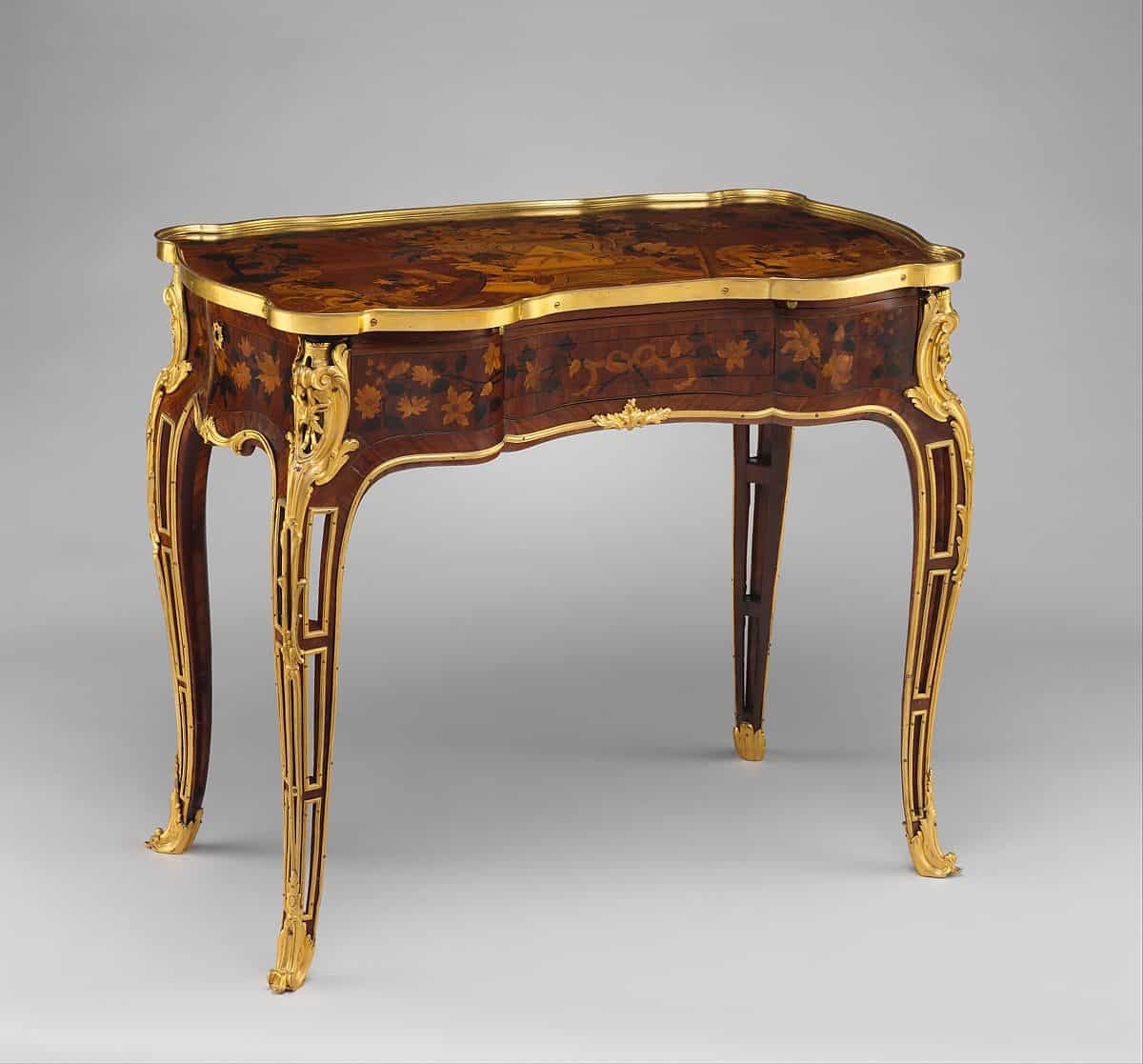
Even Marie Antoinette commissioned one in 1781 that became the first of its kind, thanks to the clever placement of a mirror that could be taken out and folded away at will. This made it easier to use the table as a desk whilst still retaining the ability to work as a dressing table.
The Victorian Era
The dressing table began to be known as such in the late 1800s, during the Victorian era. These dressing tables featured mirrors, small drawers to keep cosmetics and accessories in, and a small stool to sit at.
The tables were designed with the trends of the time in mind, with many reflecting the popular revival styles that were in fashion.
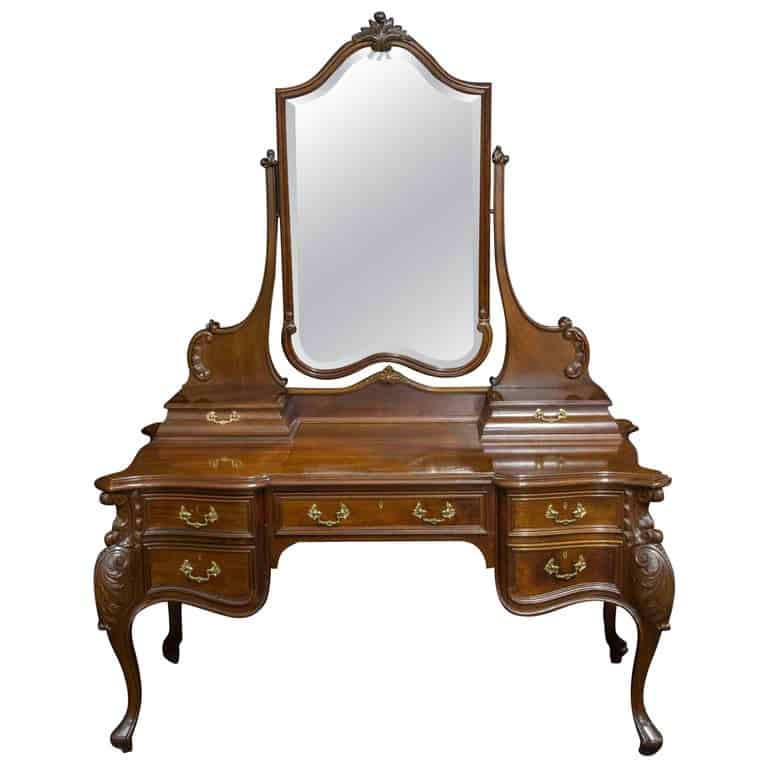
Art Deco Period up to Modern Day
Up until this point, dressing tables were used by both genders, but the dawn of the Art Deco period in the early 20th century decreed the dressing table as a distinctly feminine item of furniture.
The 1933 film “Dinner at Eight” cemented this view with the design of Jean Harlow’s boudoir, and many took inspiration from the film.
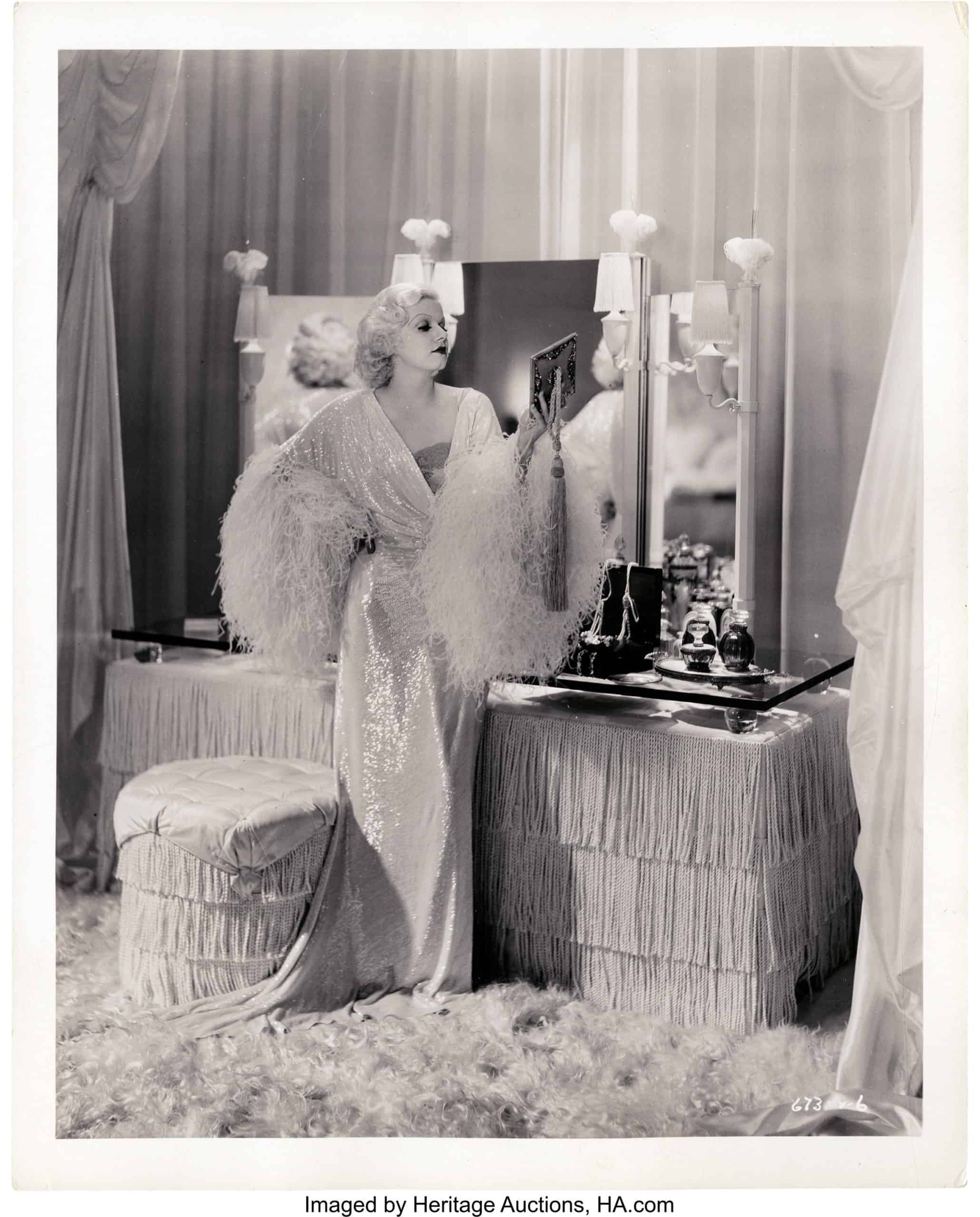
The advent of World War II brought the popularity of the dressing table to an all time low. People were more focused on surviving to bother with making themselves look their best, and money was better spent on supplies.
Once the War ended, dressing tables came back into fashion and have remained stylish features in bedrooms and closets right up until today.
How to Identify an Antique Dressing Table
Now that we have covered the history of the dressing table, we can discuss how to identify a genuine antique dressing table. The types of antique vanity tables you are most likely to find are either Georgian, Victorian, Edwardian, or Art Deco.
Below, we will dive into the various styles and types to identify which belong to each period, with references to points made by Hemswell Antiques on their website:
Georgian Dressing Tables
Georgian dressing tables are the first of their kind, featuring innovative designs by the master craftsmen of the 18th century. They have many hidden features such as folding lids, sliding mirrors, built-in drawers, compartments, and boxes.
As mentioned above, they often doubled as a writing desk or were used for practical purposes, so these hidden compartments often contained more than makeup and trinkets. Some may have had inkwells or a place to store quills and ink.
These tables were known as ‘lowboys’, ‘tallboys’, and ‘poudreuse tables’, after the height of the table and the woman who made them a trend across the continent respectively. Another name found in Britain was ‘Queen Anne’, after the Queen of England at the time.
A mahogany dressing table was the most popular, but they could be made of other types of wood such as maple. The drawers have decorative brass handles to pull them out with, whilst the legs of the table tend to be thin and straight or slightly curved.
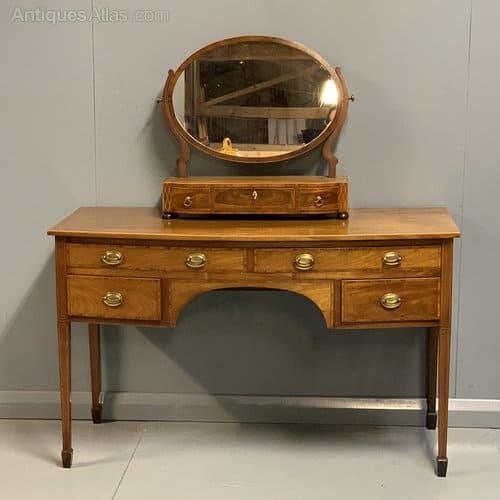
Victorian Dressing Tables
19th century vanity tables tended to be made according to whichever style was in fashion at the time. Because the era featured so many different revivals, it is possible to get a dressing table that is very different from one made just ten years later.
The most popular tables are known as ‘Duchess dressing tables’, and the type of material used to make them is usually a high-quality wood such as mahogany, rosewood, oak, or walnut. The wood may also be veneered.
Their design incorporates a square or oval-shaped large mirror along with small drawers built into the table. Victorian vanity tables tend to be ornate, with turned legs and dainty feet. Drawers have ‘knobs’ screwed onto them.
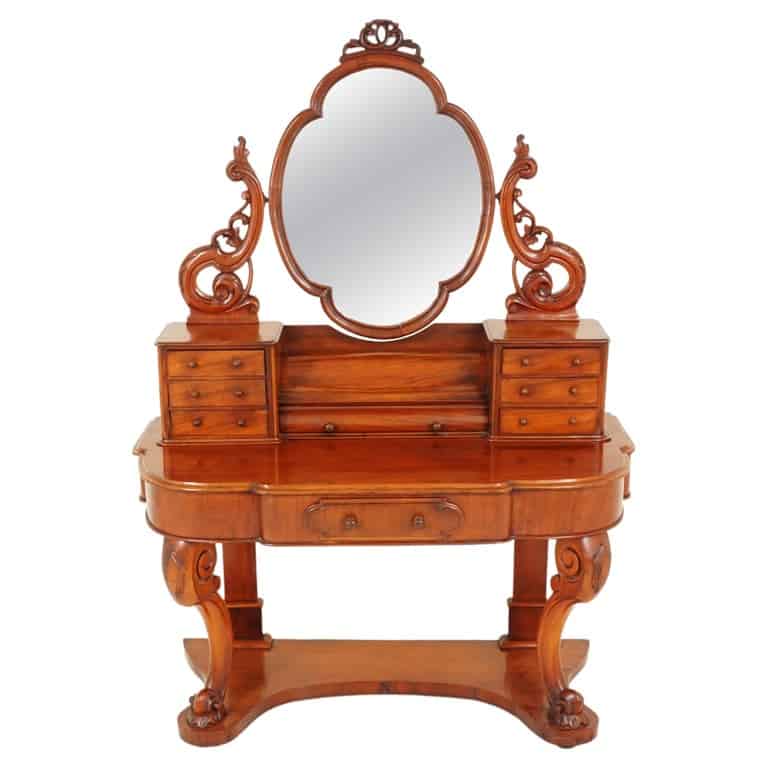
Edwardian Dressing Tables
Edwardian dressing tables often reflect the Victorian style in design with their mirrors, drawers, and a space to put toiletries. They are similar to the Duchess, but they are plainer, have straighter lines and sometimes feature smaller mirrors either side of the main mirror.
Some also feature mirrors that have a different shape to the traditional square or oval, as well as having simple brass handles and can be made of pine or oak if they were crafted with a middle-class customer in mind.
Some dressing tables may even have marble as a tabletop feature or some simple carving either around the mirror or down the legs, though it is more common to see marble embellishments on Victorian dressing tables.
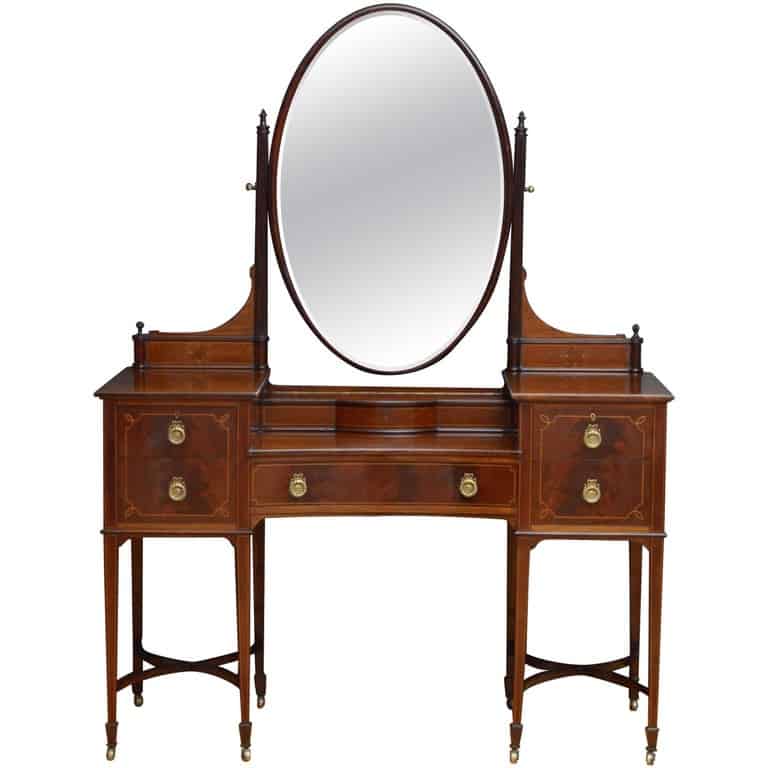
Art Deco Dressing Tables
Art Deco vanities were crafted in the 1910s-1920s and were a development of the Art Nouveau style. Art Nouveau features delicate figured motifs, carved wooden supports to hold the mirrors, and central curved lines.
Art Deco is much simpler, with repetitive patterns of geometric shapes, veneers, less carved decoration, and was much sleeker in design. Some had a stool built into the table thanks to a cleverly carved spiral of wood.
The mirrors tend to be round or oval and the table itself tends to be made of walnut or mahogany. Sometimes the wood is painted a different colour through either restoration or a previous owner’s preference.
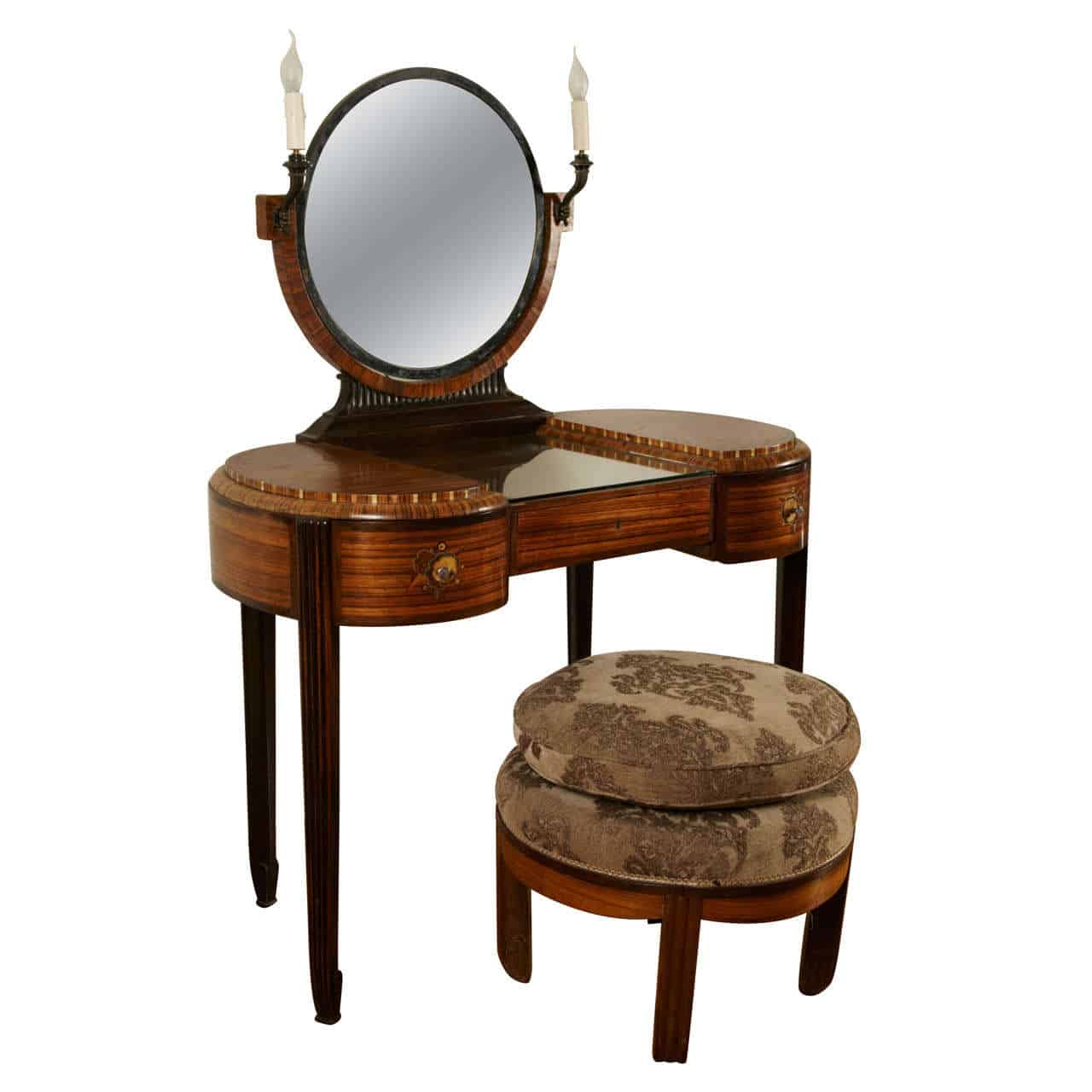
Are Antique Dressers Worth Anything?
Antique dressers can be very expensive depending on the era they were made, the furniture makers behind the piece, the material they are made from, whether they are in good condition upon selling, and the rarity of the piece.
To discover the potential value of each type, we will look at the Love Antiques website and compare the most expensive and least expensive, and the differences between the two that justify the price gap.
Georgian Dressing Tables
Georgian vanity tables are being sold on the website for anything between £500 to £9750. The most expensive one is made from amboyna and brass and was part of a collection of furniture previously owned by Sir William Whitfield, a famous architect.
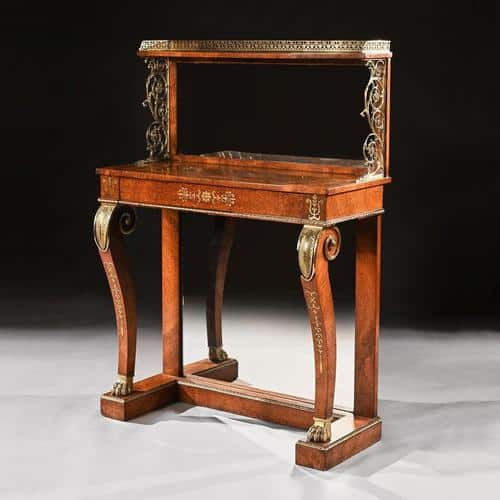
In contrast, the cheapest available Georgian vanity table is made from mahogany and satinwood and is advertised as a miniature dressing table with three folded mirrors. It has no known ties to famed historical figures, and no added gilding.
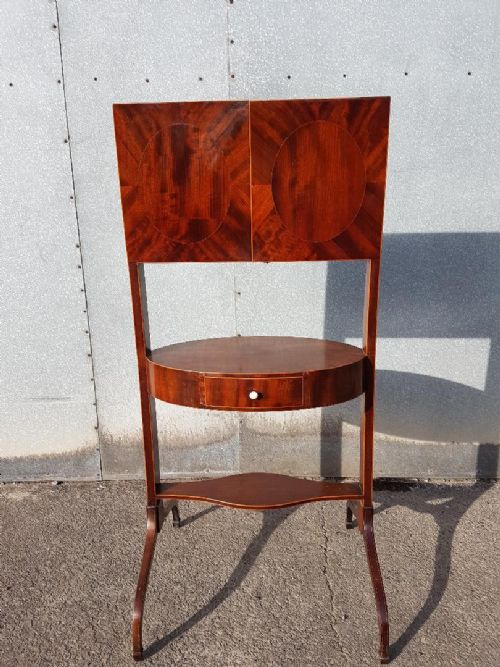
Victorian Dressing Tables
Victorian dressing tables are highly popular in today’s market and often sell for high prices. The price range on the website is between £575 to £8950. The former is a pine dressing table with a single rectangular mirror with carved wooden supports and multiple drawers.
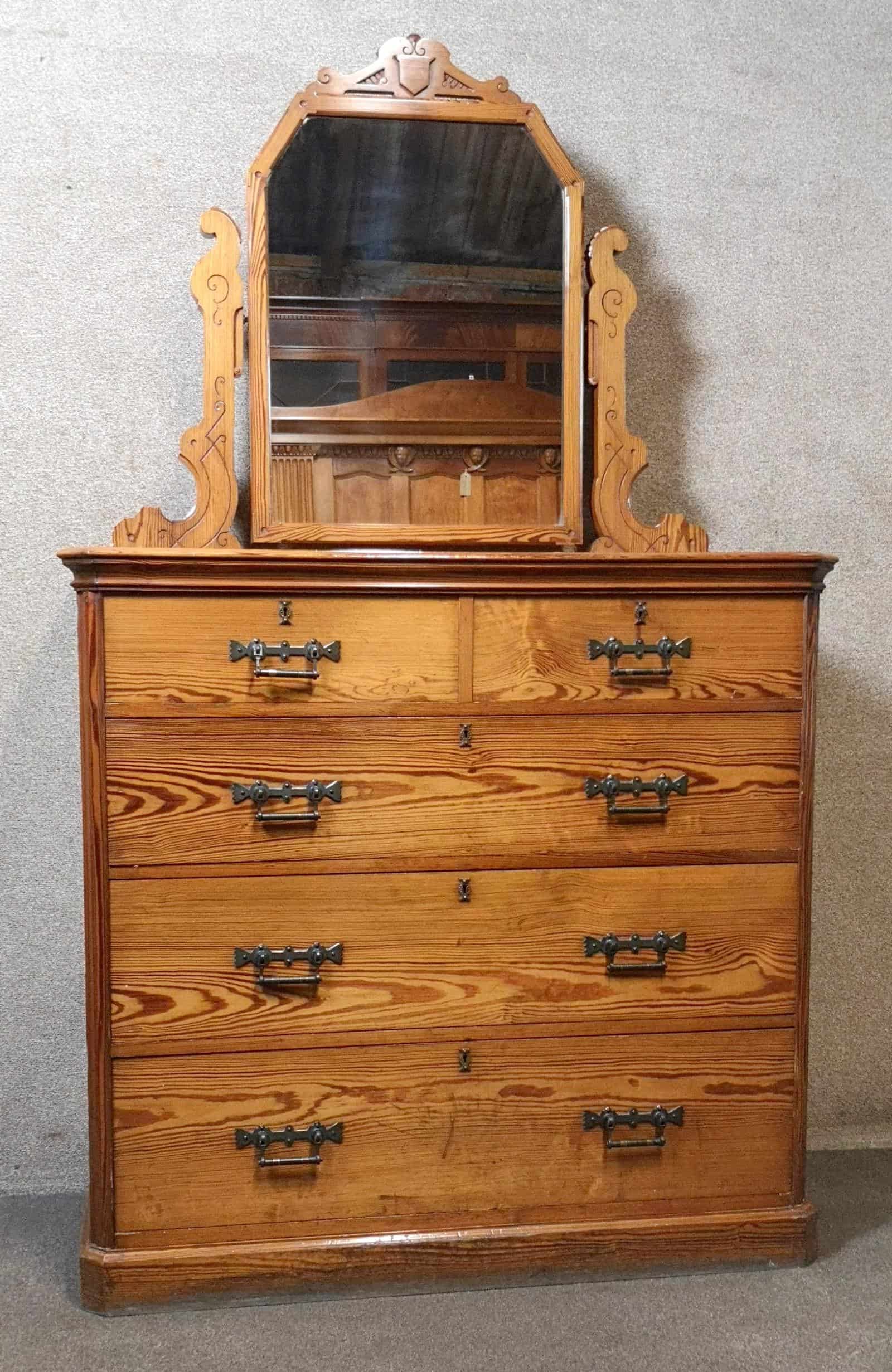
The most expensive is an ornate dressing table made from a myriad of high-quality wood, most likely mahogany and oak, with floral marquetry decorating the entire piece. There is a large mirror that has a carved frame and three wide drawers with the original handles.
Edwardian Dressing Tables
Edwardian vanities tend to be the cheapest of the four and are currently selling between £195 to £2950. The cheapest is a mahogany dressing table with a simple design and four drawers with simple handles.
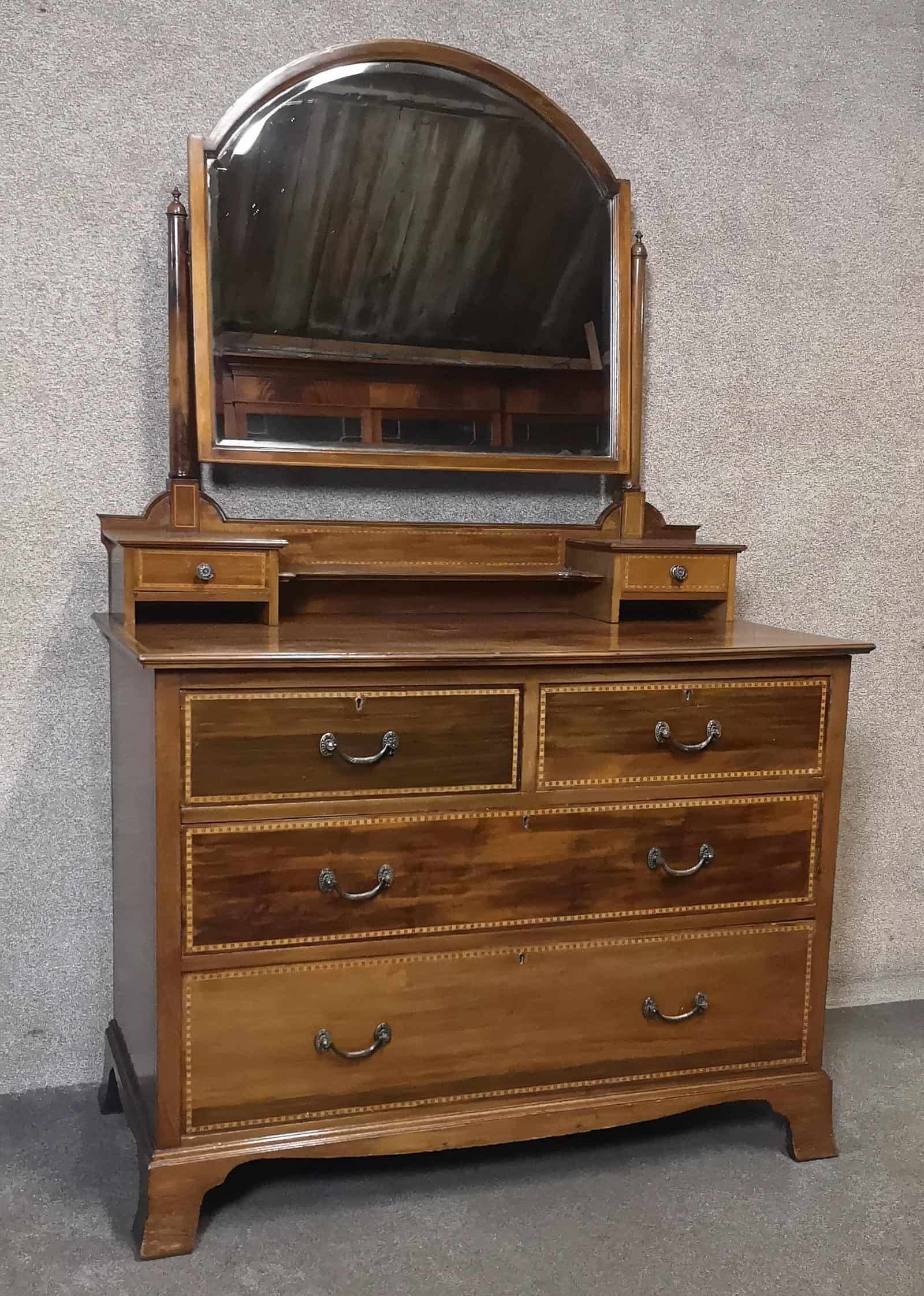
The more expensive dressing table is a wide satinwood table that can double as a writing desk thanks to its design. It is plain but has five built-in drawers with brass handles and is in very good condition.
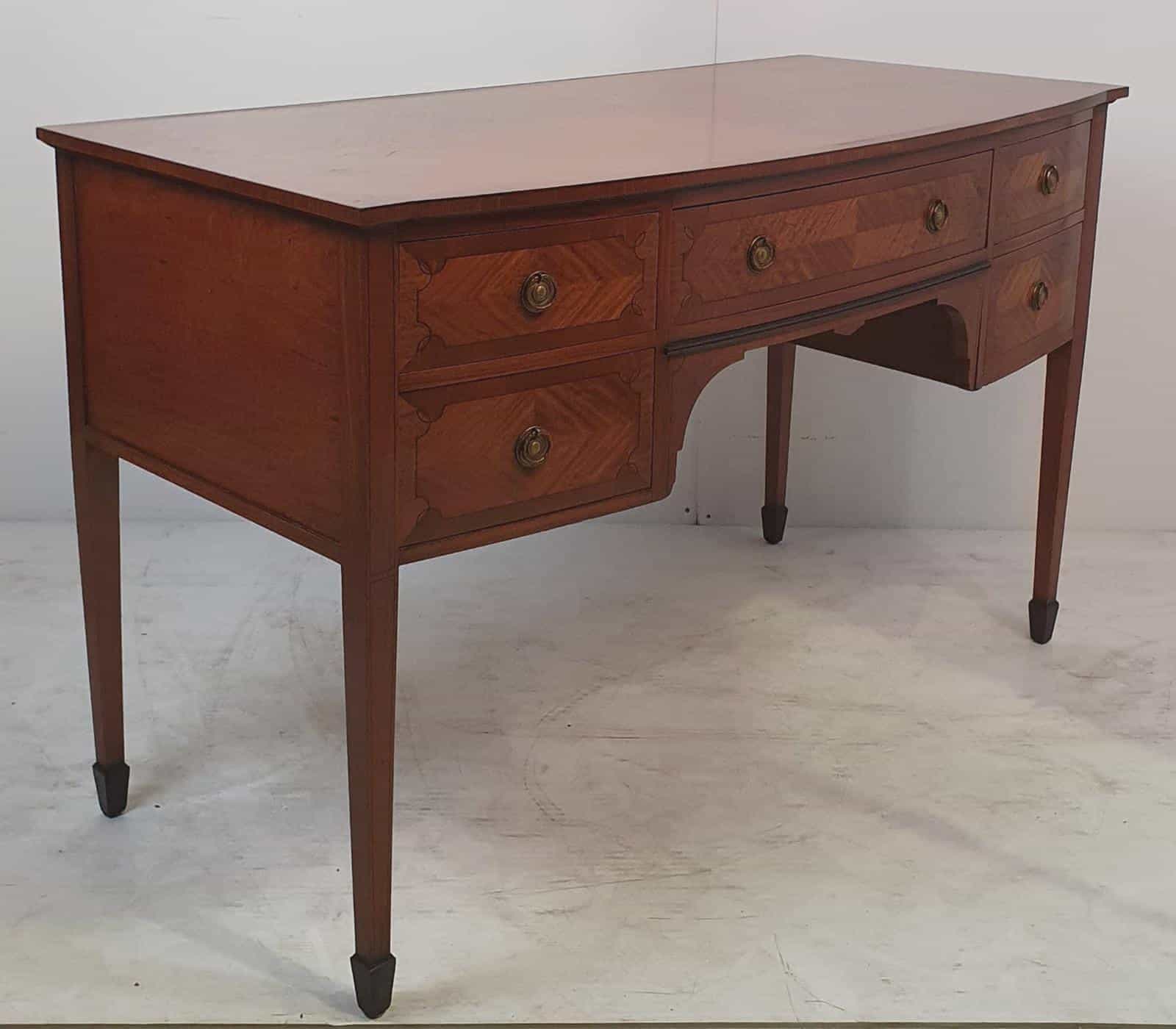
Art Deco Dressing Tables
Art Deco pieces appeal to a specific kind of buyer as they have a bolder design. There is still an active market for them, but Love Antiques currently have no Art Deco dressing tables on offer. Because of this, I have used another site, Vinterior, for reference.
The price bracket for an Art Deco dressing table on this website ranges between £108 to £12000. The cheapest table is made from walnut and features a rectangular mirror, two side mirrors, and six small drawers along with one bigger drawer. It is in a fairly good condition.
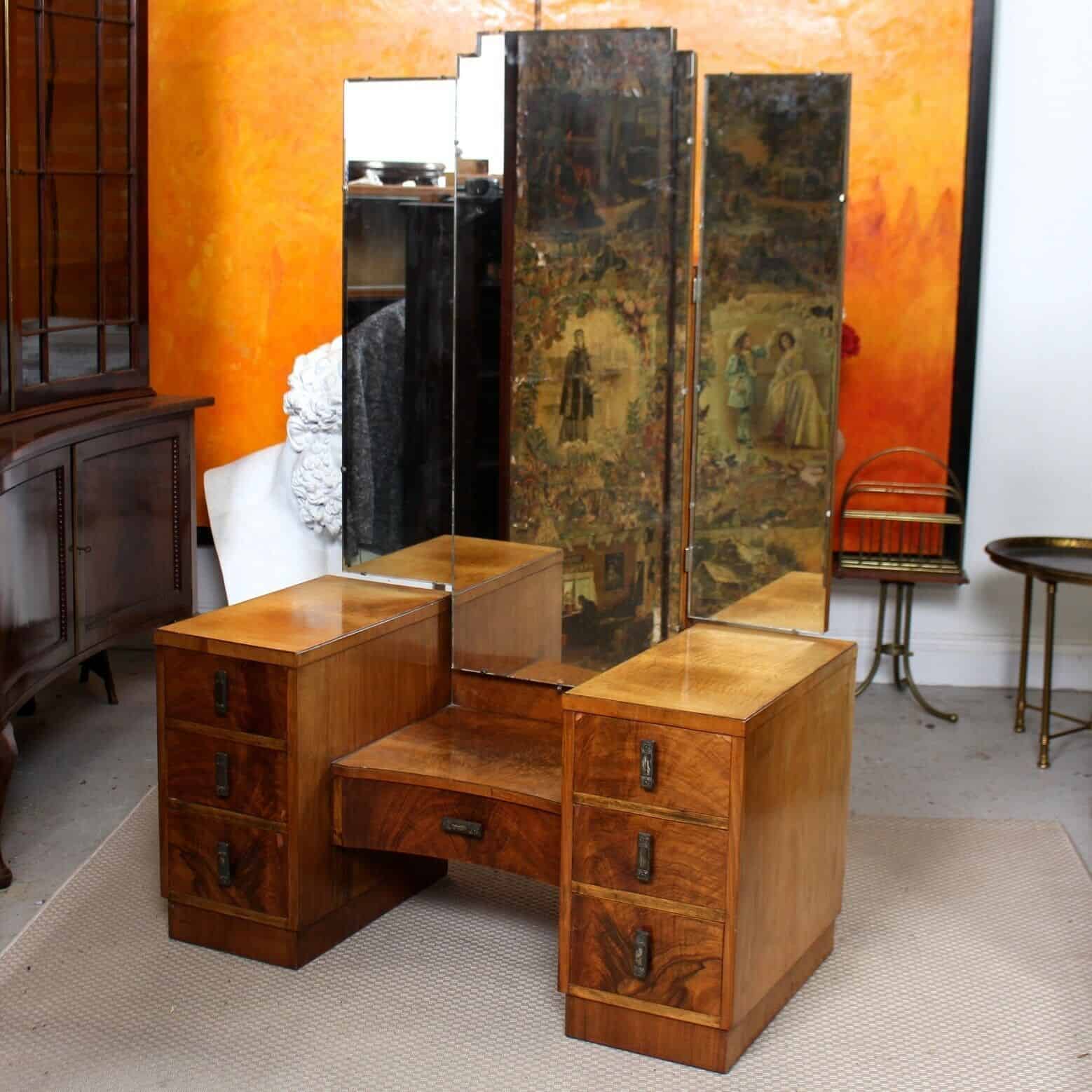
The most expensive table is a unique French maple and ivory vanity with a full-length mirror and decorative wings either side. It was made by Mercier Freres, a French furniture and tapestry firm that supplied furniture to various royal courts, most notably the Spanish court.
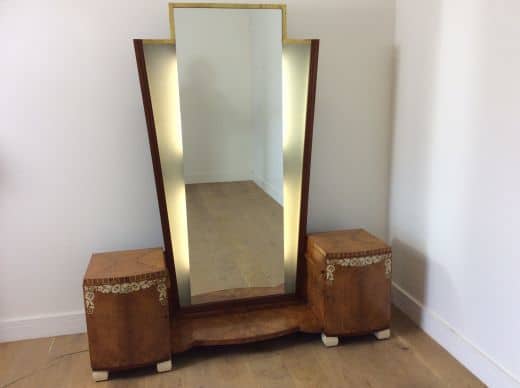
Though the Art Deco era has the most expensive dressing table, the prices range so much that it doesn’t make it the overall most expensive era. Judging by the research I have conducted, that title belongs to the Georgian vanity tables.
You can use these statistics to estimate how much your dressing table could be worth by comparing the design, condition, and material of the piece to the ones on the websites. You can also look for a manufacturer’s tag or find out the name of a previous owner.
What to Look for When Purchasing an Antique Dressing Table
There are various factors to look out for when purchasing an antique vanity table. First, you would need to take a good look at the condition of the piece.
Antiques World has some extremely useful tips to help you study the condition of a dressing table:
- Check the finish on the wood – if it is the original finish then you should maintain it rather than restore it if possible. It should be smooth, clean, and waxed.
- If the table has been polished, ensure it has been done by a professional using the traditional method as any other way damages the wood.
- Look for signs of rot or decay in the structure that could be caused by woodworm. Fixing furniture affected by woodworm can be time-consuming and expensive. If the seller has treated the affected area prior to purchase, tap it to check if dust falls out.
- Identify any repairs that need to be made – from minor repairs such as a missing drawer handle to major repairs like cracks or holes in the wood.
- Make sure all the drawers open without sticking and that the mirror is in good condition with little to no damage. If the drawers are lined, check the material has no tears or holes that small items could fall through.
- If the table comes with a stool, check the upholstery for signs of damage. You are most likely to get leather or fabric-covered stools, so ensure there are no rips, missing pieces, or obvious stains.
- It is unlikely to find an antique dressing table in pristine condition due to the age of the piece, but it is possible to get good quality tables that have endured through time via the longevity of the material and strength of the structure as a whole.
FAQs
Below are some of the FAQs when identifying or buying an antique dressing table:
Who invented the dressing table?
There is no clear answer as to who invented the very first dressing table, however, early versions were called ‘toilet tables’ and Madame de Pompadour is credited with making them popular during the 18th century.
How and where can you get your antique dressing table valued?
Antique dealers, auction houses, or a professional antique appraiser can give you a detailed estimate of the value of your dressing table.
An online search can also provide you with a rough estimate if you look up similar pieces that have been sold in the past either through a dealer, an antique shop, an auction, or a private buyer.
How to Restore an antique dressing table
Do all antique dressing tables have mirrors?
No, as many dressing tables made before the 1900s had either small mirrors or no mirror as the glass was expensive. It wasn’t until the Edwardian era that mirrors became the main focus of the dressing table.
Where can you buy an antique dressing table?
There are several places you can purchase the table of your choice. There are online stores dedicated to selling antique furniture that often have dressing tables from multiple eras.
Sometimes, second-hand websites such as eBay can have antique dressing tables listed, but you must check the reputability of the seller before buying.
You can also go to your local antique dealer or to an auction to study the table in person, check for damages, and decide what you’re willing to pay.
Conclusion
To conclude, to identify antique dressing tables, you must:
- Identify the era they were made.
- Compare the style, material, and design of the table to others on the market.
- Check for a manufacturer’s tag or the name of a previous owner.
- Ensure that the method used to create the dressing table is in line with the era it was reportedly made.
I hope you have found this article to be informative and enjoyable to read. If you have any comments or questions, please leave them in the box below and we will get back to you as soon as possible.
